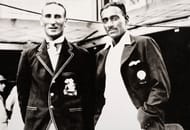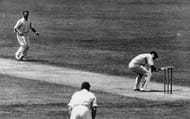“B*st**d… B*st**d… B*st**d” – The entire Adelaide Oval vented their anger as the Australian keeper Bert Oldfield lay on the ground, almost senseless, with a fractured skull. The entire Australian squad ran out on the field to help “Oldie” off the ground as the opposition stood surrounded by angry fans chanting expletives.
Injuries are a part of cricket. Every cricketer has found himself grimacing with pain at some point in his career. But what happens when the sole objective of your opposition is to hurt you physically and stretcher you off the field?
An explosion that changes the game forever!
“Bradman….Bradman…Bradman…” – The Melbourne Cricket ground echoed the name of the greatest batsman in the history of cricket on his return to the Ashes in 1932 after missing out the first Test. The master batsman gleefully accepted the hero’s welcome, but little did he know what his opposition had in store for him.
Two leg slips, leg gully, deep fine leg, long leg, short square leg and a very silly mid on – that’s how the English captain greeted Sir Don Bradman to the crease. Bradman took guard, Bill Bowes ran in, dug the ball short at his ribs, Bradman swiveled to play the pull shot but only managed to drag the ball on to his stumps – the trick had worked. Bradman walked back for a golden duck!
How do you stop a batsman who amassed 974 runs at a batting average of 139.14 in a five-Test series?
You possibly can’t.
All you can try is to find a weakness, lay a trap and hope that your bowlers exploit it. But when someone goes on to record a career batting average of 99.94, it suggests that not many succeeded in exploiting them.
One man did. Douglas Jardine.
Jardine was perhaps the only man who dared to cross the line to take a serious crack at the greatest batsman the world had ever seen.
In 1928, Jardine traveled to Australia with the MCC team along with England’s new pace sensation Harold Larwood. If England handed the Test caps to Jardine and Larwood, Australia introduced the boy wonder from Bowral, Donald Bradman. Although Bradman had a modest Test debut, he left an indelible mark on Jardine. He returned to England and declared Bradman as the greatest that the world will ever see.
“He can do things, no other batsman can. He is unstoppable” – Douglas Jardine proclaimed after the 1928 tour.
The MCC Lords laughed off Jardine’s words, but their jaws hit their knees with amazement when Bradman took centre-stage and launched an onslaught in the 1930 Ashes tour. He toyed with England’s bowling and ended up with extraordinary scores that dented the confidence of England’s fastest bowler, Harold Larwood, who nurtured thoughts of giving up cricket after his sufferings in the hands of the Aussie master.
However, among this carnage, Bradman unknowingly left a clue that led to one of the most controversial Test series ever.
“I feel sure something new will have to be introduced to curb Bradman.” - Percy Fender, the Surrey captain, said after being on the receiving end of a Bradman assault.
Fender was right. After his record-breaking 1930 Ashes, England needed fresh ideas and outlandish tactics to rein in Bradman’s almost supernatural skills. They needed a plan and a man who would not only stand up to the Aussie genius but also would end his tyrannical master-class.

Enter Douglas Jardine. England appointed Jardine for the job of bringing back the Ashes and in the quest for the sacred urn, Jardine envisaged an idea – an idea so strong that it shook the foundations of the game.
To appreciate Douglas Jardine, one has to travel back in time to understand the times he grew up in. Born in Bombay, Douglas Jardine was the part of the British Raj. He grew up in a world that saw British dominance around the world and was tutored in the quintessential British qualities of bull-headed determination, cold-hearted resolve, and patrician disdain. Being brought up in the Raj-era, he also had an ingrained hatred towards the Australians, whom he often referred to as “Barbarians”.
Jardine was sent to Winchester at the tender age of nine. Separated from his parents, Jardine struggled to fend off bullies in school. Though he had the talent, he couldn’t unleash his full potential until he met Rockley Wilson. Wilson became his mentor and passed on the most important advice of his life –
“You don’t bowl a batsman out…you plan him out!”
Under Wilson’s tutelage, Jardine flourished as a batsman and a shrewd tactician. He scored heavily for Winchester and was touted as one of the finest openers after Herbert Sutcliffe. However, Jardine’s life changed when he met Percy Fender, the then captain of Surrey, during a game between Winchester and Eaton.
During this game, Jardine sidestepped the spirit of cricket for the first time. He asked one of his bowlers to “Mankad” Eaton’s best batsman without giving him a prior warning. Winchester won the game, but Jardine faced criticism from the authorities and his fellow mates.
Percy Fender, though, found nothing wrong with his methods. Fender, one of the best captains who never led England, was known for his out-of-the-box ideas and was always at war with the MCC Lords for his notorious knack of bending the rules. He congratulated Jardine for his move and took him under his wings at Surrey.
Thus began Jardine’s foray into leadership. After replacing Fender as the Surrey captain, Jardine took over “Mission Australia” in 1932. He believed that to beat Australia, England had to beat Bradman first. So Jardine’s main focus was to recognize that one elusive weakness of Don Bradman. He went through his batting reels, talked to bowlers and spent sleepless nights going through his records.
However, it was Harold Larwood, who accidentally handed Jardine the breakthrough while revisiting Bradman’s double hundred at the Oval.
“I’ve got him…he’s yellow” – That was it! Jardine came up with his famous “leg-theory” while watching Bradman’s reel at Percy Fender’s house. On a lively Oval track, when Larwood bowled short at his body, Bradman flinched and didn’t look at ease.
Jardine decided to implement the “leg –theory” to stop Don Bradman. He had the plan but needed a lethal weapon who would execute it with aplomb. He didn’t just need a bowler; he needed a bowler seeking revenge. He needed Harold Larwood. Jardine selected a five-man pace battery, spearheaded by the dangerous Harold Larwood, to neutralize Don Bradman and bring the Ashes back to the English shores.
The idea was conceived at Fender’s house, tried out at the nets in Surrey, explained in the train to Melbourne and finally perfected at the first warm up game. Jardine didn’t take the field but instructed Bob Wyatt, the stand-in captain, to let the three fast men bowl short at the batsman’s body to a packed leg-side field. It surprised the Aussies but they didn’t know what awaited them.
The following five Tests saw Voce, Bowes and Larwood relentlessly throw down a barrage of short pitch deliveries at the batsmen with seven fielders on the leg side with terrifying results– broken ribs, fractured skulls and unprecedented on and off field hostility.
The battered and bruised Aussie cricketers protested, but the board didn’t listen. Pelham Warner, the manager of the MCC team, warned Jardine of the consequences, but Jardine didn’t budge and events took a nasty turn at Adelaide. Bill Woodfull received a snorter from Larwood in his ribs that saw the Aussie captain go down wincing in pain. The non-striker, Bradman, and the entire English team ran towards him, but Jardine stood his ground applauding, “Well bowled Harold!”
Much to the bewilderment of the batsmen, he switched the fielders towards the leg side and signaled Larwood to bowl at Woodfull’s body. The Adelaide crowd watched in amazement, brimming with anger, but Bert Oldfield’s injury sent them into complete frenzy and the name of Douglas Jardine became synonymous to “unsporting” behavior.
England regained the Ashes but every action has its consequences. The MCC banned the “leg-theory” and treated Jardine as an outcast. The world resented his actions. Australian fans burned the Union Jack flag during the Sydney Test to express their anger at his tactics. And Jardine etched his name as the “Inglorious B*st**d” of Test cricket.
But was he wrong in what he did? Or was he reprimanded for being clinically efficient?
There was nothing illegal about Bodyline. Jardine found a weakness and built a strategy around it. He had immense respect for Bradman but decided to fight him with fire rather than platitude. He just proved that no athlete is perfect and no matter how powerful your enemy is, there’s always a way to weaken him. His strategy worked and perhaps that led to his downfall.
Douglas Jardine is regarded as the biggest villain in cricket history because society tends to vilify what they don’t understand. Jardine’s outstanding batting ability was forgotten and he was maligned for life. Jardine was a complex man motivated by a cause. He believed that he infantry wages the war, but it’s the generals who win them. He was appointed for a job and he delivered.
The cricket world didn’t understand him and robbed him off his achievement. He was a great captain, but his tactical genius became his biggest enemy. The world detested him because he won in an era where the “bad guy” wasn’t supposed to win.
Cricket history might remember him as the one who stooped to conquer, but Douglas Jardine was the first captain who proved that a strategy can even fend off the best. England needed a super villain to stop Bradman’s super-heroic efforts and Jardine enacted it to the tee. He may have been wrong, but he and his men scripted a story that would live on as long as cricket will be played, because, as Alfred Hitchcock once said:
“The more successful the villain, the more successful the picture…”
A dramatization of the 1932/33 Test cricket series between England and Australia..?
Follow IPL Auction 2025 Live Updates, News & Biddings at Sportskeeda. Get the fastest updates on Mega-Auction and cricket news


